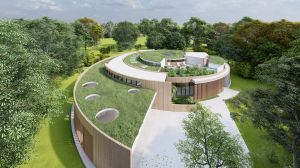Text...
Prefabricated Buildings benefits

Prefabricated construction is the practice of assembling a variety of components of a structure at a manufacturing site and transporting those sub-assemblies to the location of the construction jobsite. Prefabricated construction is sometimes thought of as a low-end and mass produced mode of construction. In reality however, it is quite the opposite. Prefabricated construction is becoming more common, improving in quality and has become available in a variety of budgets. Despite the perception of prefabrication, there are numerous benefits to this type of construction. This article assesses the advantages that prefabricated construction presents for both businesses and customers.
Eco-Friendly
Modular construction is often commended for energy efficiency and sustainable construction. Traditional construction methods require extra materials that lead to increased waste. However, since prefabricated sub-assemblies are constructed in a factory, extra materials can be recycled in-house. This is a considerable improvement over sending waste directly to a landfill from a traditional construction site. Also, the controlled environment of a factory allows for more accurate construction, tighter joints and better air filtration, which in turn allows for better wall insulation and an increase in energy efficiency. For more on the benefits of green technology in the construction industry click HERE.
Financial Savings
One of the greatest advantages of prefabricated construction would be financial savings. Although the perception of custom-made pieces may seem expensive, with prefabricated or modular construction, this is not the case. Modular construction targets all budgets and price points, creating an affordable option. Prefabrication manufacturers often receive bulk discounts from material suppliers which then trickles down to the cost of a construction project. Modular construction also sidesteps the possibility of unreliable contractors and unproductive staff. Additionally, the reduction in construction time can significantly save on construction financing costs.
Flexibility
Modular construction can be easily be disassembled and relocated to different sites. This significantly reduces the demand for raw materials, minimizes expended energy and decreases time overall. Also, modular construction allows for flexibility in the design of the structure allowing for a limitless number of opportunities. Since prefabricated construction units can be used in different spaces, its neutral aesthetics is able to blend in with almost any building type.
Consistent Quality
Since prefabricated construction occurs in a controlled manufacturing environment and follows specified standards, the sub-assemblies of the structure will be built to a uniform quality. Construction site-built structures are dependent upon varying skill levels and the schedules of independent contractors. These all contribute to the craftsmanship and overall quality of given structure. With prefabrication, each sub-assembly is built by an experienced crew in a weather-resistant factory, with multiple quality checks throughout the entire process. Some components of the building are constructed using precise machine equipment to ensure conformity to building code.
Reduced Site Disruption
Since many components of a building are completed in the factory, there is significantly less truck traffic, equipment and material suppliers around the final construction site. This limits the disruption of traditional jobsites that suffer from noise, pollution, waste and other common irritants. This streamlined approach to construction provides a far more efficient atmosphere for productivity, and eliminates unnecessary distractions and interference that are typical of construction sites.
Shorter Construction Time
Portable construction takes significantly less time to build than on-site construction. In many instances, prefabrication takes less than half the time when compared to traditional construction. This is due to better upfront planning, elimination of on-site weather factors, subcontractor scheduling delays and quicker fabrication as multiple pieces can be constructed simultaneously. Shorter construction times allows construction companies to take on multiple projects at once, allowing businesses to grow rather than putting all their focus and resources on one or a few projects at a time.
Safety
Since sub-assemblies are created in a factory-controlled environment utilizing dry materials, there is less risk for problems associated with moisture, environmental hazards and dirt. This ensures that those on the construction site, as well as a project’s eventual tenants are less likely to be exposed to weather-related health risks. Also, an indoor construction environment presents considerably fewer risks for accidents and other liabilities. There are strict factory processes and procedures that protect the worker from on-the-job injury. At a construction site, although safety is of utmost importance, workers are subjected to weather-related conditions, changing ground conditions, wind and other crew members who are at the site.
Final Thoughts
With the continued popularity of prefabricated construction, it is likely that it will only continue to grow in popularity. Customers who choose this option are able to enjoy a high quality, quicker, cost-effective, and eco-friendly construction method. Furthermore, construction companies may soon increase their investment in modular construction processes, benefiting both their business and customer relationships. Prefabricated construction is proving to be an extremely viable option, and as manufacturing technology continues to improve, expect to see its benefits and advantages rise in the future.





